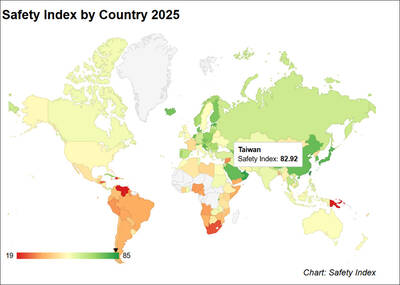The recent discovery of an outbreak in Chilean turkey farms also raised concerns that swine flu could combine with avian influenza and become a more dangerous virus, the UN Food and Agriculture Organization (FAO) said.
“The current H1N1 virus strain is a mixture of human, pig and bird [flu] genes and has proved to be very contagious but no more deadly than common seasonal flu viruses,” the Rome-based agency said in a statement.
“However, it could theoretically become more dangerous if it adds virulence by combining with H5N1, commonly known as avian flu, which is far more deadly but harder to pass along among humans,” it said.
The FAO said Chile did not have avian influenza, also known as bird flu, and the turkeys represented the first case of H1N1 among birds.
Around the world at least 2,185 people have died from swine flu, an official from the WHO said yesterday. However a spokesman said the latest figure “understates” the total number of deaths.
Britain and France have received their first batches of swine flu vaccine, officials said on Thursday, as governments began to arm themselves against a second wave of the pandemic in the northern winter.
Doses to combat the pandemic arrived as millions of schoolchildren prepared to return to school in the next two weeks, with concerns that the virus could spread easily between classrooms.
In South Korea, the education ministry announced that all elementary and secondary schoolchildren — 7.5 million students at 11,000 schools — will have their temperature checked daily to combat the spread of H1N1 when they return to school next week.
British and French health officials said the H1N1 vaccine should win licensing approval for distribution in their countries by October.
Belgium said it would get its first doses next month.
Spain said on Thursday it planned to start swine flu vaccinations in late October or early November, as the country recorded its 20th death from the illness.
The first shipment of swine flu vaccine is expected to arrive in New Zealand early next month and vaccinations are likely to start early next year, officials said yesterday.
The government of Nicaragua has declared a 60-day health emergency because of an upswing in the number of cases and deaths.
Health Minister Guillermo Gonzalez told the Radio Ya station that the measure was declared after the number of accumulated cases rose to 840 cases this month, and four women have died since Aug. 14.
Australia yesterday said a massive swine flu vaccination program would start in October, but warned of a possible “second wave” of infections in the hard-hit country.
Chief medical officer Jim Bishop said he was hopeful A(H1N1) influenza had peaked, with 147 related deaths and almost 35,000 cases, but cautioned it could surge again.
However, the swine flu could re-emerge next year in a more deadly form, an expert said on Thursday.
“We should get through the winter relatively easily, I don’t think the virus will mutate before then,” said John Oxford, a professor of virology at Britain’s St Bartholomew’s and the Royal London Hospital.
“For the moment, the virus is running around the world finding lots of young people and infecting them. It is doing very nicely, thank you, why should it change?” he said by telephone.
“Once the virus has infected about a third of the world’s population — which is what we expect — it will find less ‘susceptibles.’ That is when mutants will have a selective advantage,” he said.

AIR SUPPORT: The Ministry of National Defense thanked the US for the delivery, adding that it was an indicator of the White House’s commitment to the Taiwan Relations Act Deputy Minister of National Defense Po Horng-huei (柏鴻輝) and Representative to the US Alexander Yui on Friday attended a delivery ceremony for the first of Taiwan’s long-awaited 66 F-16C/D Block 70 jets at a Lockheed Martin Corp factory in Greenville, South Carolina. “We are so proud to be the global home of the F-16 and to support Taiwan’s air defense capabilities,” US Representative William Timmons wrote on X, alongside a photograph of Taiwanese and US officials at the event. The F-16C/D Block 70 jets Taiwan ordered have the same capabilities as aircraft that had been upgraded to F-16Vs. The batch of Lockheed Martin

GRIDLOCK: The National Fire Agency’s Special Search and Rescue team is on standby to travel to the countries to help out with the rescue effort A powerful earthquake rocked Myanmar and neighboring Thailand yesterday, killing at least three people in Bangkok and burying dozens when a high-rise building under construction collapsed. Footage shared on social media from Myanmar’s second-largest city showed widespread destruction, raising fears that many were trapped under the rubble or killed. The magnitude 7.7 earthquake, with an epicenter near Mandalay in Myanmar, struck at midday and was followed by a strong magnitude 6.4 aftershock. The extent of death, injury and destruction — especially in Myanmar, which is embroiled in a civil war and where information is tightly controlled at the best of times —

Taiwan was ranked the fourth-safest country in the world with a score of 82.9, trailing only Andorra, the United Arab Emirates and Qatar in Numbeo’s Safety Index by Country report. Taiwan’s score improved by 0.1 points compared with last year’s mid-year report, which had Taiwan fourth with a score of 82.8. However, both scores were lower than in last year’s first review, when Taiwan scored 83.3, and are a long way from when Taiwan was named the second-safest country in the world in 2021, scoring 84.8. Taiwan ranked higher than Singapore in ninth with a score of 77.4 and Japan in 10th with

SECURITY RISK: If there is a conflict between China and Taiwan, ‘there would likely be significant consequences to global economic and security interests,’ it said China remains the top military and cyber threat to the US and continues to make progress on capabilities to seize Taiwan, a report by US intelligence agencies said on Tuesday. The report provides an overview of the “collective insights” of top US intelligence agencies about the security threats to the US posed by foreign nations and criminal organizations. In its Annual Threat Assessment, the agencies divided threats facing the US into two broad categories, “nonstate transnational criminals and terrorists” and “major state actors,” with China, Russia, Iran and North Korea named. Of those countries, “China presents the most comprehensive and robust military threat